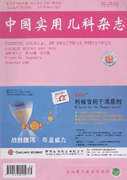Objective To explore the mechanisms of visfatin in fetal growth. Methods From Dec.2008 to Dec.2009,the cord blood plasmaconcentrations of visfatin in 90 term neonates at birth in Wuxi Maternal and Child Health Hospital,Wuxi No.3 People’s Hospital and Wuxi Xishan Hospital was measured by Elisa and its mRNA expression by quantitative real-time PCR in placenta.The correlation between birth weight ,cord blood visfatin,and mRNA expression was analyzed. Results Cord blood concentration of visfatin in IUGR were significantly higher than that of fetal macrosomia and healthy term infants(P < 0.05),while there was no difference between fetal macrosomia and healthy term infants(P > 0.05).There was no difference in visfatin mRNA expression in placenta between the three subgroups. Regression analysis revealed that cord blood visfatin levels were inversely(r = -0.416,P < 0.05)correlated with birth weight,while visfatin mRNA expression was correlated with neither birth weight nor cord blood visfatin(P > 0.05). Conclusion Concentrations of cord blood visfatin are significantly higher in the IUGR than in the fetal macrosomia and healthy term infants,although no differences in its mRNA expression in placenta are observed.

